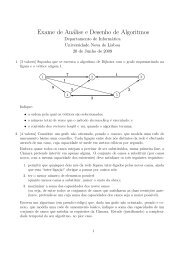Security Articles from Wikipedia
Security Articles from Wikipedia
Security Articles from Wikipedia
You also want an ePaper? Increase the reach of your titles
YUMPU automatically turns print PDFs into web optimized ePapers that Google loves.
Public key infrastructure 97<br />
Systems Agency (DISA) PKI infrastructure for the Common Access Cards program.<br />
<strong>Security</strong> issues<br />
• See PKI security issues with X.509<br />
• See Breach of Comodo CA<br />
• See Breach of Diginotar CA<br />
Usage examples<br />
PKIs of one type or another, and <strong>from</strong> any of several vendors, have many uses, including providing public keys and<br />
bindings to user identities which are used for:<br />
• Encryption and/or sender authentication of e-mail messages (e.g., using OpenPGP or S/MIME).<br />
• Encryption and/or authentication of documents (e.g., the XML Signature [7] or XML Encryption [8] standards if<br />
documents are encoded as XML).<br />
• Authentication of users to applications (e.g., smart card logon, client authentication with SSL). There's<br />
experimental usage for digitally signed HTTP authentication in the Enigform and mod_openpgp projects.<br />
• Bootstrapping secure communication protocols, such as Internet key exchange (IKE) and SSL. In both of these,<br />
initial set-up of a secure channel (a "security association") uses asymmetric key (a.k.a. public key) methods,<br />
whereas actual communication uses faster symmetric key (a.k.a. secret key) methods.<br />
• Mobile signatures [9] are electronic signatures that are created using a mobile device and rely on signature or<br />
certification services in a location independent telecommunication environment.<br />
• Universal Metering Interface (UMI) an open standard, originally created by Cambridge Consultants for use in<br />
Smart Metering devices/systems and home automation, uses a PKI infrastructure for security.<br />
Terminology<br />
• CA: Certificate authority<br />
• TTP: Trusted third party<br />
References<br />
[1] "LPKI - A Lightweight Public Key Infrastructure for the Mobile Environments" (http:/ / ieeexplore. ieee. org/ xpl/ freeabs_all.<br />
jsp?arnumber=4737164), Proceedings of the 11th IEEE International Conference on Communication Systems (IEEE ICCS'08), pp.162-166,<br />
Guangzhou, China, Nov. 2008.<br />
[2] Vacca, Jhn R. (2004). Public key infrastructure: building trusted applications and Web services (http:/ / books. google. com/<br />
books?id=3kS8XDALWWYC& pg=PA8). CRC Press. p. 8. ISBN 9780849308222. .<br />
[3] McKinley, Barton (January 17, 2001). "The ABCs of PKI: Decrypting the complex task of setting up a public-key infrastructure" (http:/ /<br />
www. networkworld. com/ research/ 2000/ 0117feat. html). Network World. .<br />
[4] Single Sign-On Technology for SAP Enterprises: What does SAP have to say? (http:/ / www. secude. com/ html/ ?id=1890)<br />
[5] Ed Gerck, Overview of Certification Systems: x.509, CA, PGP and SKIP, in The Black Hat Briefings '99, http:/ / www. securitytechnet. com/<br />
resource/ rsc-center/ presentation/ black/ vegas99/ certover. pdf and http:/ / mcwg. org/ mcg-mirror/ cert. htm<br />
[6] Stephen Wilson, Dec 2005, "The importance of PKI today" (http:/ / www. china-cic. org. cn/ english/ digital library/ 200512/ 3. pdf), China<br />
Communications, Retrieved on 2010-12-13<br />
[7] http:/ / www. w3. org/ TR/ xmldsig-core/<br />
[8] http:/ / www. w3. org/ TR/ xmlenc-core/<br />
[9] Mark Gasson, Martin Meints, Kevin Warwick (2005), D3.2: A study on PKI and biometrics (http:/ / www. fidis. net/ resources/ deliverables/<br />
hightechid/ #c1785), FIDIS deliverable (3)2, July 2005









